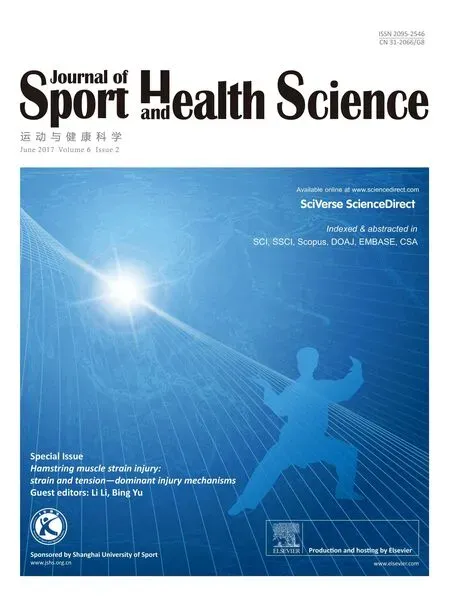Innovative running-related researches
Li Li
School of Health and Kinesiology,Georgia Southern University,Statesboro,GA 30460,USA
Innovative running-related researches
Li Li
School of Health and Kinesiology,Georgia Southern University,Statesboro,GA 30460,USA
There was a surge in published research related to barefoot running in the past 2 decades,and especially in the past 5 years. For example,the number of returns for“barefoot running”in Google Scholar increased dramatically relative to the search returns for“running”(Fig.1).“Running”related returns started at about 220,000 in 1997 and peaked at about 376,000 in 2007 (a 0.7 times increase)and gradually decreased to less than 70,000 in 2016.In contrast,“barefoot running”related returns started at 945 in 1997 and peaked at 5010 in 2012(a 4.3 times increase).Between 2007 and 2012,the number of returns for“running”decreased,but the number of returns for“barefoot running”increased.Although these numbers may not be the exact numbers of peer reviewed publications related to the searched terms,they re flect the general trend in these research areas.
With the increase of publications on“barefoot running”,the depth of the research also increased.The 2 review papers by Davis et al.1and Hamill and Gruber2published in this issue summarize the recent trends in running-related research,and demonstrate the use of innovative ideas and methods.
The 2 reviews differ on the question of whether we should support changes in running footfall patterns.Davis and colleagues1favor the idea that changing from rearfoot landing (typical for running with cushioned shoes)to forefoot landing (typical for barefoot running)is a good thing,while Hamill and Gruber2are more skeptical about such an abrupt change in footfall patterns,and suggest that some crucial questions need to be answered first before agreeing a final decision can be made.
While most people studying footfall patterns in running focus on the mechanical properties of the shoes and the ground reach forces,Davis and co-workers1focused on recent literature describing the tissue mechanics of the foot during running.The performance and mechanical properties of the heel pad,the plantar fascia,and the Achilles tendon were considered important in deciding what footfall pattern might be best for runnerstrying to avoid injuries.In contrast to Davis and colleagues, Hamill and Gruber2focused on the biomechanics and physiology of footfall patterns as they relate to the economy of running,and they pointed out the con flicting findings when studying impact peaks in time and frequency domains using wavelet analysis.

Fig.1.Number of returns for the years 1997–2016 when searching for“barefoot running”and“running”on Google Scholar(search performed on February 5,2017).
The number of publications on“running”peaked 10 years ago.However,“barefoot running”and novel and sophisticated analysis procedures are driving running biomechanics research to new insights and important findings,and although the number of“running”papers has decreased,the quality of the research and the sophistication of approaches has given new life to one of the best studied areas in sport biomechanics and physiology.
Competing interests
The author declares that he has no competing interests.
6 February 2017;accepted 8 February 2017
Available online 16 March 2017
Peer review under responsibility of Shanghai University of Sport.
E-mail address:lili@georgiasouthern.edu
http://dx.doi.org/10.1016/j.jshs.2017.03.007
2095-2546/?2017 Production and hosting by Elsevier B.V.on behalf of Shanghai University of Sport.This is an open access article under the CC BY-NC-ND license(http://creativecommons.org/licenses/by-nc-nd/4.0/).
1.Davis IS,Rice HM,Wearing SC.Why forefoot striking in minimal shoes might positively change the course of running injuries.J Sport Health Sci2017;6:154–61.
2.Hamill J,Gruber AH.Is changing footfall patterns bene ficial to runners?J
Sport Health Sci2017;6:146–53.
 Journal of Sport and Health Science2017年2期
Journal of Sport and Health Science2017年2期
- Journal of Sport and Health Science的其它文章
- Erratum to“Effects of music and video on perceived exertion during high-intensity exercise”[J Sport Health Sci 6(2017)81–88]
- Erratum to“A systematic review of active video games on rehabilitative outcomes among older patients”[J Sport Health Sci 6(2017)33–43]
- Erratum to“Children’s expectancy beliefs and subjective task values through two years of school-based program and associated links to physical education enjoyment and physical activity”[J Sport Health Sci 5(2016)500–508]
- Promoting physical activity among Chinese youth:No time to wait
- Could titin have a role in strain-induced injuries?
- Parallel and cross-sectional hamstring injuries in sprint running
